Retrieval of Fractional Snow Cover over High Mountain Asia Using 1 km and 5 km AVHRR/2 with Simulated Mid-Infrared Reflective Band
Abstract
:1. Introduction
2. Study Areas and Data Sources
2.1. Study Areas
2.2. Advanced Very High Resolution Radiometer (AVHRR) Data
2.3. Landsat 4/5 Thematic Mapper (TM) Data
2.4. Auxiliary Data
3. Methodology
3.1. Simulated 3.75 μm Band Reflectance of AVHRR/2 1 km Data
3.2. Snow Index (SI) Algorithm
3.3. Non-Snow/Snow Two Endmember Model (TEM) Algorithm
3.4. Multiple Endmember Spectral Mixture Analysis Algorithm Based on the Automatic Endmember Extraction (MESMA) Algorithm
3.5. Evaluation Metrics
4. Results
4.1. Results and Evaluation in High Mountain Asia
4.2. Evaluation for Different Surface Types
4.3. Evaluation at Different Altitudes
5. Discussion
6. Conclusions
Author Contributions
Funding
Data Availability Statement
Acknowledgments
Conflicts of Interest
References
- Wulf, H.; Bookhagen, B.; Scherler, D. Differentiating between rain, snow, and glacier contributions to river discharge in the western Himalaya using remote-sensing data and distributed hydrological modeling. Adv. Water Resour. 2016, 88, 152–169. [Google Scholar] [CrossRef] [Green Version]
- Huang, X.; Deng, J.; Wang, W.; Feng, Q.; Liang, T.G. Impact of climate and elevation on snow cover using integrated remote sensing snow products in Tibetan Plateau. Remote Sens. Environ. 2017, 190, 274–288. [Google Scholar] [CrossRef]
- Tang, Z.; Ma, J.; Peng, H.; Wang, S.; Wei, J. Spatiotemporal changes of vegetation and their responses to temperature and precipitation in upper Shiyang river basin. Adv. Space Res. 2017, 60, 969–979. [Google Scholar] [CrossRef]
- Ling, F.; Zhang, T. A numerical model for surface energy balance and thermal regime of the active layer and permafrost containing unfrozen water. Cold Reg. Sci. Technol. 2004, 38, 1–15. [Google Scholar] [CrossRef]
- Dedieu, J.P.; Lessard-Fontaine, A.; Ravazzani, G.; Cremonese, E.; Shalpykova, G.; Beniston, M. Shifting mountain snow patterns in a changing climate from remote sensing retrieval. Sci. Total Environ. 2014, 493, 1267–1279. [Google Scholar] [CrossRef] [PubMed] [Green Version]
- Barnett, T.P.; Adam, J.C.; Lettenmaier, D.P. Potential impacts of a warming climate on water availability in snow-dominated regions. Nature 2005, 438, 303–309. [Google Scholar] [CrossRef]
- Xu, Y.; Jones, A.; Rhoades, A. A quantitative method to decompose SWE differences between regional climate models and reanalysis datasets. Sci. Rep. 2019, 9, 16520. [Google Scholar] [CrossRef] [Green Version]
- Tang, Z.; Wang, J.; Li, H.; Liang, J.; Wang, X.; Li, H.; Jiang, Z. Extraction and assessment of snowline altitude over the Tibetan plateau using MODIS fractional snow cover data (2001 to 2013). J. Appl. Remote Sens. 2014, 8, 084689. [Google Scholar] [CrossRef]
- Tang, Z.; Wang, X.; Wang, J.; Wang, X.; Li, H.; Jiang, Z. Spatiotemporal variation of snow cover in Tianshan Mountains, Central Asia, based on cloud-free MODIS fractional snow cover product, 2001–2015. Remote Sens. 2017, 9, 1045. [Google Scholar] [CrossRef] [Green Version]
- Dozier, J. Spectral Signature of Alpine Snow Cover from the Landsat Thematic Mapper. Remote Sens. Environ. 1989, 28, 9–22. [Google Scholar] [CrossRef]
- Tang, Z.; Wang, X.; Deng, G.; Wang, X.; Jiang, Z.; Sang, G. Spatiotemporal variation of snowline altitude at the end of melting season across High Mountain Asia, using MODIS snow cover product. Adv. Space Res. 2020, 66, 2629–2645. [Google Scholar] [CrossRef]
- Deng, G.; Tang, Z.; Hu, G.; Wang, J.; Sang, G.; Li, J. Spatiotemporal dynamics of snowline altitude and their responses to climate change in the Tienshan Mountains, Central Asia, During 2001–2019. Sustainability 2021, 13, 3992. [Google Scholar] [CrossRef]
- Salomonson, V.V.; Appel, I. Estimating fractional snow cover from MODIS using the normalized difference snow index. Remote Sens. Environ. 2004, 89, 351–360. [Google Scholar] [CrossRef]
- Salomonson, V.V.; Appel, I. Development of the Aqua MODIS NDSI fractional snow cover algorithm and validation results. IEEE Trans. Geosci. Remote Sens. 2006, 44, 1747–1756. [Google Scholar] [CrossRef]
- Slater, M.T.; Sloggett, D.R.; Rees, W.G.; Steel, A. Potential operational multi-satellite sensor mapping of snow cover in maritime sub-polar regions. Int. J. Remote Sens. 1999, 20, 3019–3030. [Google Scholar] [CrossRef]
- Metsämäki, S.; Pulliainen, J.; Salminen, M.; Luojus, K.; Wiesmann, A.; Solberg, R.; Böttcher, K.; Hiltunen, M.; Ripper, E. Introduction to GlobSnow Snow Extent products with considerations for accuracy assessment. Remote Sens. Environ. 2015, 156, 96–108. [Google Scholar] [CrossRef]
- Metsamaki, S.J.; Anttila, S.T.; Markus, H.J.; Vepsalainen, J.M. A feasible method for fractional snow cover mapping in boreal zone based on a reflectance model. Remote Sens. Environ. 2005, 95, 77–95. [Google Scholar] [CrossRef]
- Painter, T.H.; Dozier, J.; Roberts, D.A.; Davis, R.E.; Green, R.O. Retrieval of subpixel snow-covered area and grain size from imaging spectrometer data. Remote Sens. Environ. 2003, 85, 64–77. [Google Scholar] [CrossRef] [Green Version]
- Painter, T.H.; Rittger, K.; McKenzie, C.; Slaughter, P.; Davis, R.E.; Dozier, J. Retrieval of subpixel snow covered area, grain size, and albedo from MODIS. Remote Sens. Environ. 2009, 113, 868–879. [Google Scholar] [CrossRef] [Green Version]
- Rittger, K.; Painter, T.H.; Dozier, J. Assessment of methods for mapping snow cover from MODIS. Adv. Water Resour. 2013, 51, 367–380. [Google Scholar] [CrossRef]
- Sirguey, P.; Mathieu, R.; Arnaud, Y. Subpixel monitoring of the seasonal snow cover with MODIS at 250 m spatial resolution in the Southern Alps of New Zealand: Methodology and accuracy assessment. Remote Sens. Environ. 2009, 113, 160–181. [Google Scholar] [CrossRef]
- Moosavi, V.; Malekinezhad, H.; Shirmohammadi, B. Fractional snow cover mapping from MODIS data using wavelet-artificial intelligence hybrid models. J. Hydrol. 2014, 511, 160–170. [Google Scholar] [CrossRef]
- Czyzowska-Wisniewski, E.H.; van Leeuwen, W.J.D.; Hirschboeck, K.K.; Marsh, S.E.; Wisniewski, W.T. Fractional snow cover estimation in complex alpine-forested environments using an artificial neural network. Remote Sens. Environ. 2015, 156, 403–417. [Google Scholar] [CrossRef]
- Kuter, S.; Akyurek, Z.; Weber, G.W. Retrieval of fractional snow covered area from MODIS data by multivariate adaptive regression splines. Remote Sens. Environ. 2018, 205, 236–252. [Google Scholar] [CrossRef]
- Hou, J.; Huang, C.; Chen, W.; Zhang, Y. Improving Snow Estimates Through Assimilation of MODIS Fractional Snow Cover Data Using Machine Learning Algorithms and the Common Land Model. Water Resour. Res. 2021, 57, e2020WR029010. [Google Scholar] [CrossRef]
- Kuter, S. Completing the machine learning saga in fractional snow cover estimation from MODIS Terra reflectance data: Random forests versus support vector regression. Remote Sens. Environ. 2021, 255, 112294. [Google Scholar] [CrossRef]
- Rittger, K.; Krock, M.; Kleiber, W.; Bair, E.H.; Brodzik, M.J.; Stephenson, T.R.; Rajagopalan, B.; Bormann, K.J.; Painter, T.H. Multi-sensor fusion using random forests for daily fractional snow cover at 30 m. Remote Sens. Environ. 2021, 264, 112608. [Google Scholar] [CrossRef]
- Hall, D.K.; Riggs, G.A.; Salomonson, V.V. Development of Methods for Mapping Global Snow Cover Using Moderate Resolution Imaging Spectroradiometer Data. Remote Sens. Environ. 1995, 54, 127–140. [Google Scholar] [CrossRef]
- Riggs, G.A.; Hall, D.K.; Román, M.O. MODIS Snow Products Collection 6 User Guide. 2016. Available online: https://nsidc.org/sites/nsidc.org/files/files/MODIS-snow-user-guide-C6.pdf (accessed on 15 March 2021).
- Wang, G.; Jiang, L.; Shi, J.; Su, X. A Universal Ratio Snow Index for Fractional Snow Cover Estimation. IEEE Geosci. Remote Sens. Lett. 2021, 18, 721–725. [Google Scholar] [CrossRef]
- Naegeli, K.N.; Salberg, A.B.; Schwaizer, G.; Wiesmann, A.; Wunderle, S.; Nagler, T. ESA Snow Climate Change Initiative (Snow_cci): Daily global Snow Cover Fraction—Snow on ground (SCFG) from AVHRR (1982–2019), version 1.0. NERCEDS Centre for Environmental Data Analysis [dataset]. 2021. Available online: https://catalogue.ceda.ac.uk/uuid/5484dc1392bc43c1ace73ba38a22ac56 (accessed on 15 December 2021).
- Hori, M.; Sugiura, K.; Kobayashi, K.; Aoki, T.; Tanikawa, T.; Kuchiki, K.; Niwano, M.; Enomoto, H. A 38-year (1978–2015) Northern Hemisphere daily snow cover extent product derived using consistent objective criteria from satellite-borne optical sensors. Remote Sens. Environ. 2017, 191, 402–418. [Google Scholar] [CrossRef]
- Hao, X.; Huang, G.; Che, T.; Ji, W.; Sun, X.; Zhao, Q.; Zhao, H.; Wang, J.; Li, H.; Yang, Q. The NIEER AVHRR snow cover extent product over China—A long-term daily snow record for regional climate research. Earth Syst. Sci. Data 2021, 13, 4711–4726. [Google Scholar] [CrossRef]
- Zhu, J.; Shi, J. An Algorithm for Subpixel Snow Mapping: Extraction of a Fractional Snow-Covered Area Based on Ten-Day Composited AVHRR/2 Data of the Qinghai-Tibet Plateau. IEEE Geosci. Remote Sens. Mag. 2018, 6, 86–98. [Google Scholar] [CrossRef]
- Shi, J. An Automatic Algorithm on Estimating Sub-Pixel Snow Cover from MODIS. Quat. Sci. 2012, 32, 6–15. [Google Scholar]
- Wu, X.; Naegeli, K.; Premier, V.; Marin, C.; Ma, D.; Wang, J.; Wunderle, S. Evaluation of snow extent time series derived from Advanced Very High Resolution Radiometer global area coverage data (1982–2018) in the Hindu Kush Himalayas. Cryosphere 2021, 15, 4261–4279. [Google Scholar] [CrossRef]
- Zhang, Y.; Ren, H.; Pan, X. Integration dataset of Tibet Plateau boundary. National Tibetan Plateau Data Center [dataset]. 2021. Available online: http://data.tpdc.ac.cn (accessed on 15 March 2022). [CrossRef]
- Reuter, H.I.; Nelson, A.; Jarvis, A. An evaluation of void-filling interpolation methods for SRTM data. Int. J. Geogr. Inf. Sci. 2007, 21, 983–1008. [Google Scholar] [CrossRef]
- Chinese Academy of Sciences Resource and Environmental Science Data Center. Landuse dataset in China (1980–2015) [data set]. National Tibetan Plateau Data Center. 2019. Available online: http://www.resdc.cn/ (accessed on 15 October 2021).
- Salisbury, J.W. Johns Hopkins University Spectral Library and ASTER Spectral Library [dataset]. 2002. Available online: http://speclib.jpl.nasa.gov (accessed on 15 October 2021).
- Roger, J.C.; Vermote, E.F. A method to retrieve the reflectivity signature at 3.75 μm from AVHRR data. Remote Sens. Environ. 1998, 64, 103–114. [Google Scholar] [CrossRef]
- Kaufman, Y.J.; Kleidman, R.G.; Hall, D.K.; Martins, J.V.; Barton, J.S. Remote sensing of subpixel snow cover using 0.66 and 2.1 μm channels. Geophys. Res. Lett. 2002, 29, 28-1–28-4. [Google Scholar] [CrossRef]
- Wang, G.; Jiang, L.; Wu, S.; Shi, J.; Hao, S.; Liu, X. Fractional Snow Cover Mapping from FY-2 VISSR Imagery of China. Remote Sens. 2017, 9, 983. [Google Scholar] [CrossRef] [Green Version]
- Yang, J.; Jiang, L.; Shi, J.; Wu, S.; Sun, R.; Yang, H. Monitoring snow cover using Chinese meteorological satellite data over China. Remote Sens. Environ. 2014, 143, 192–203. [Google Scholar] [CrossRef]
- Adams, J.B.; Smith, M.O.; Johnson, P.E. Spectral Mixture Modeling—A New Analysis of Rock and Soil Types at the Viking Lander-1 Site. J. Geophys. Res.-Solid Earth Planets 1986, 91, 8098–8112. [Google Scholar] [CrossRef]
- Bateson, A.; Curtiss, B. A method for manual endmember selection and spectral unmixing. Remote Sens. Environ. 1996, 55, 229–243. [Google Scholar] [CrossRef]
- Heinz, D.C.; Chang, C.I. Fully constrained least squares linear spectral mixture analysis method for material quantification in hyperspectral imagery. IEEE Trans. Geosci. Remote Sens. 2001, 39, 529–545. [Google Scholar] [CrossRef] [Green Version]
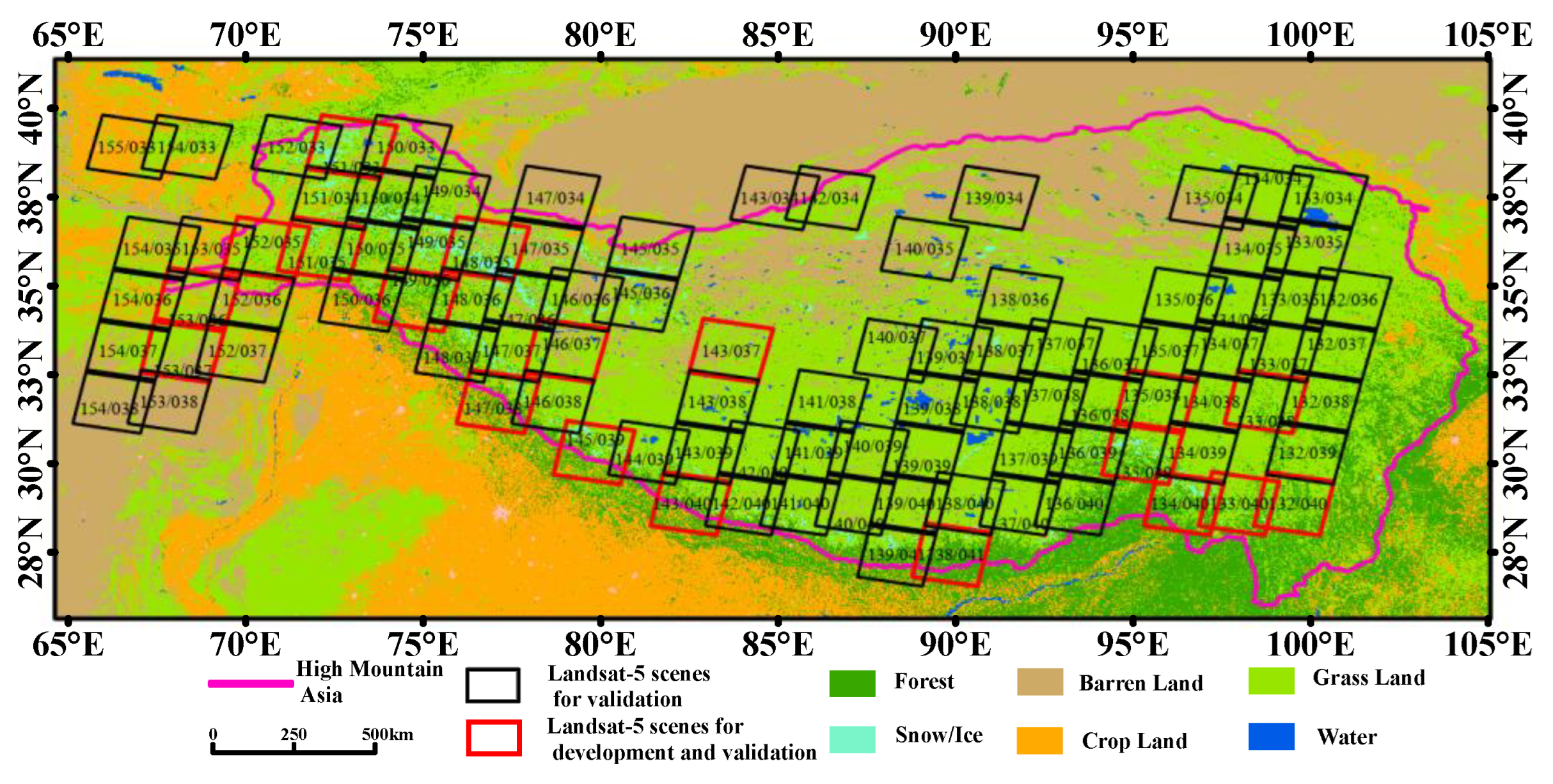
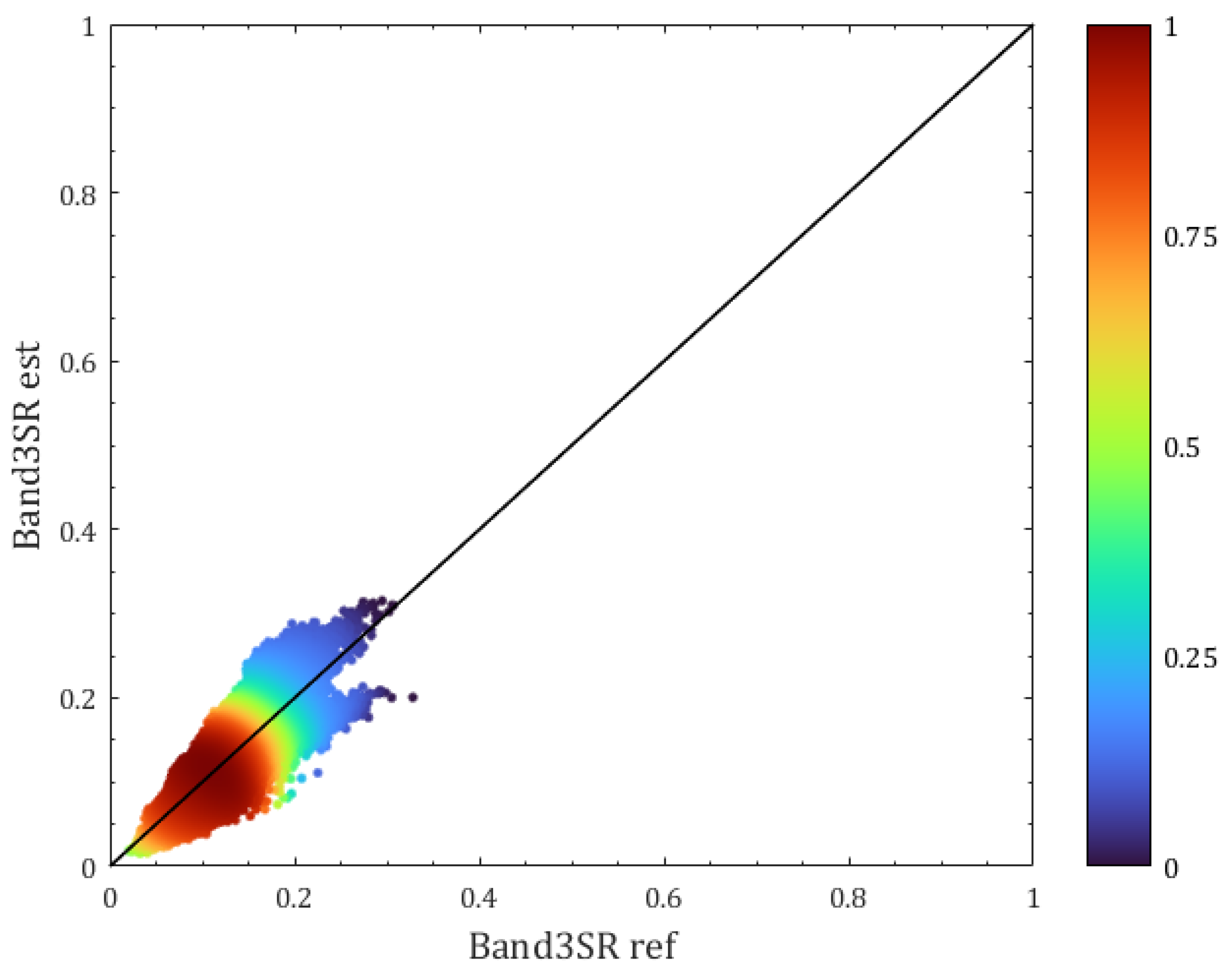
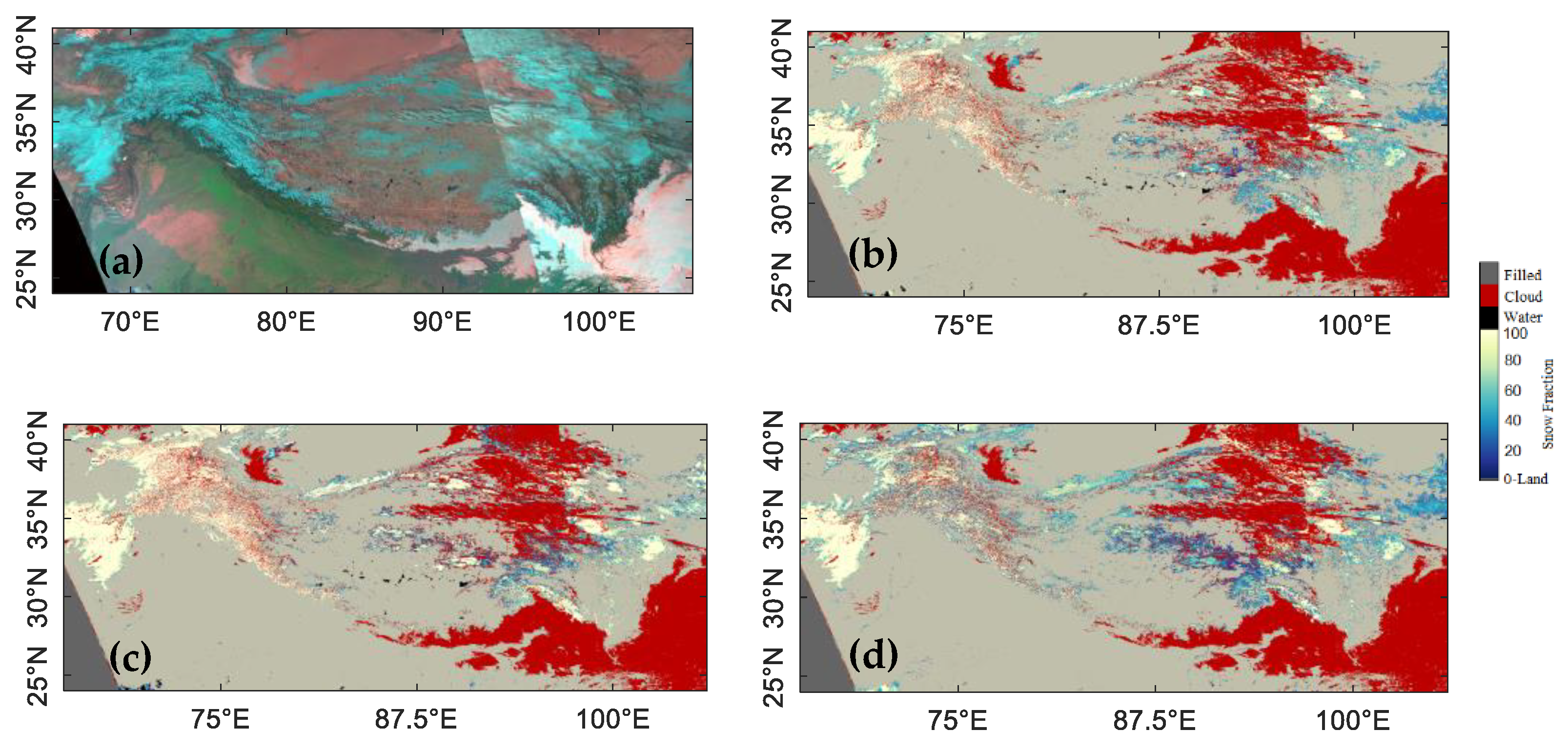

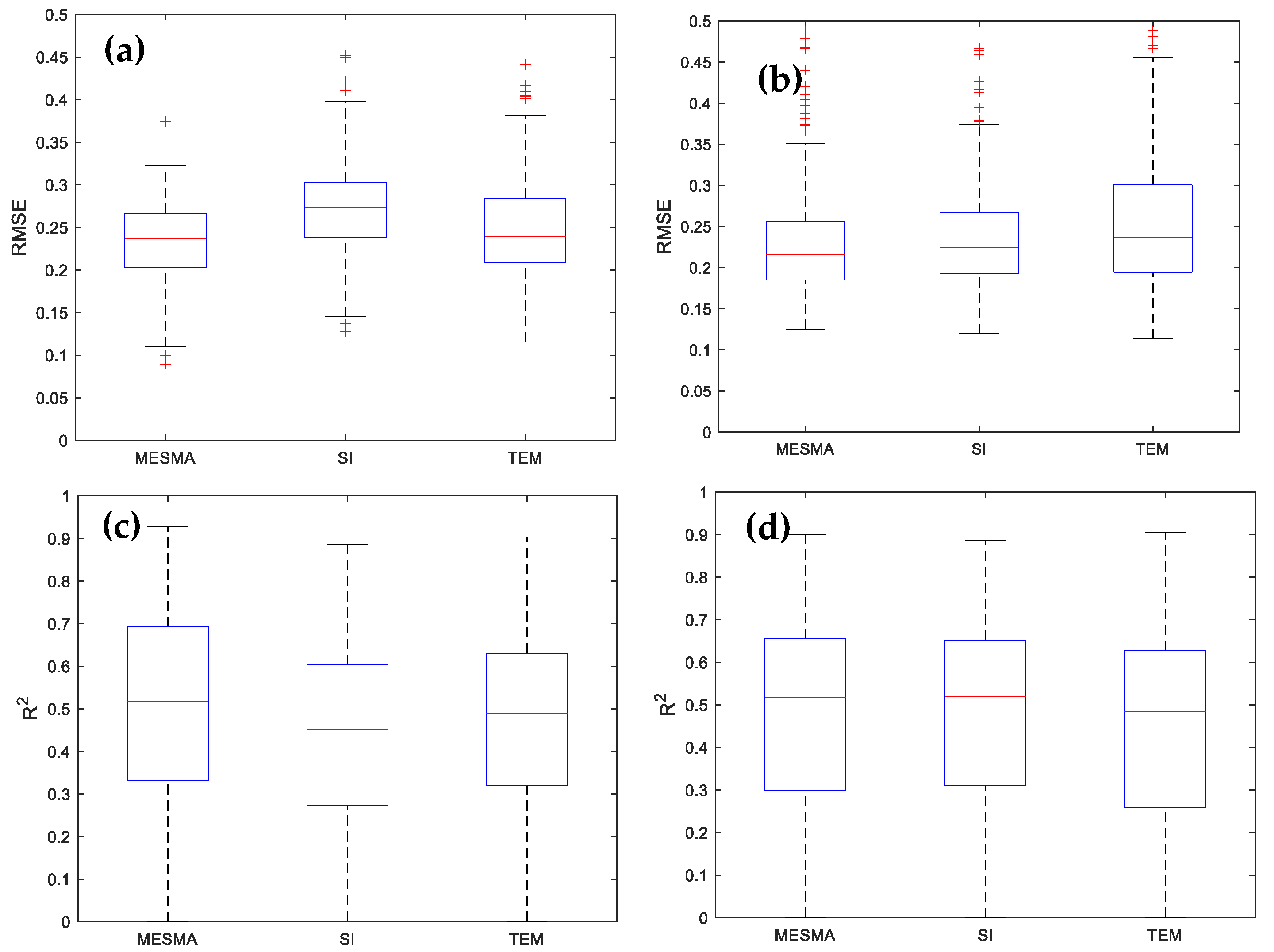
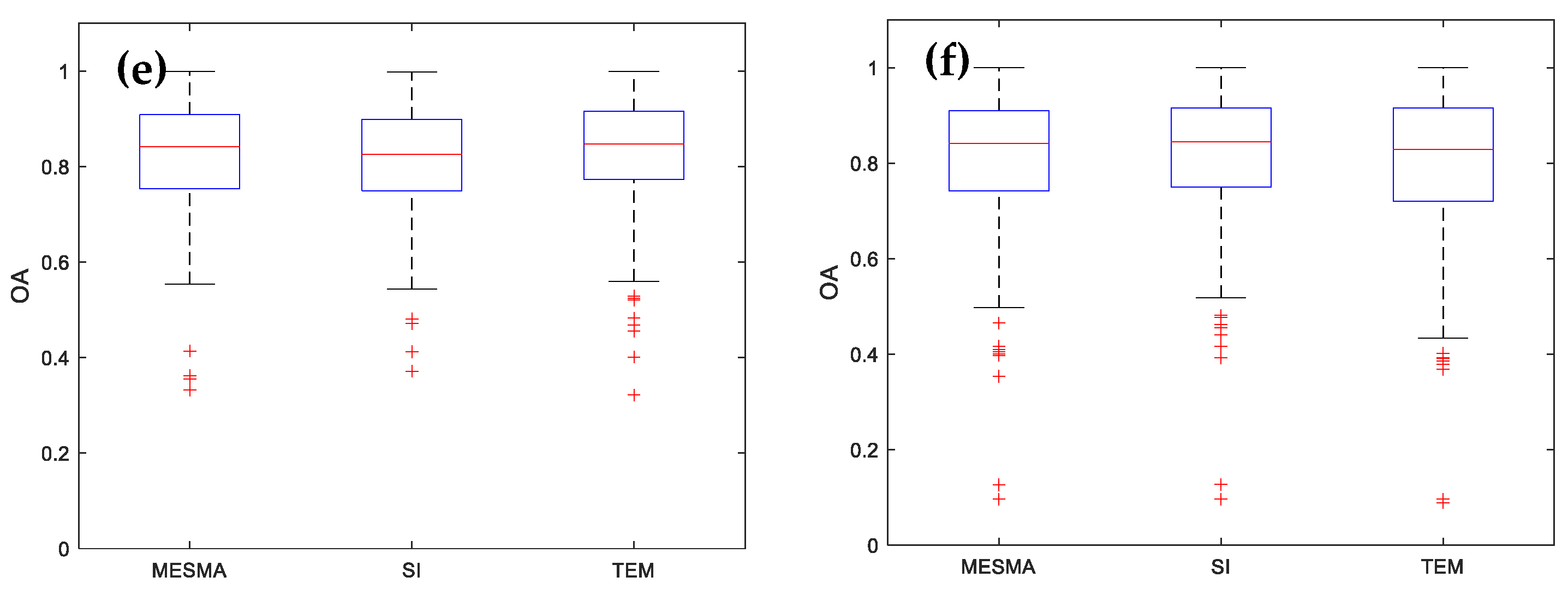
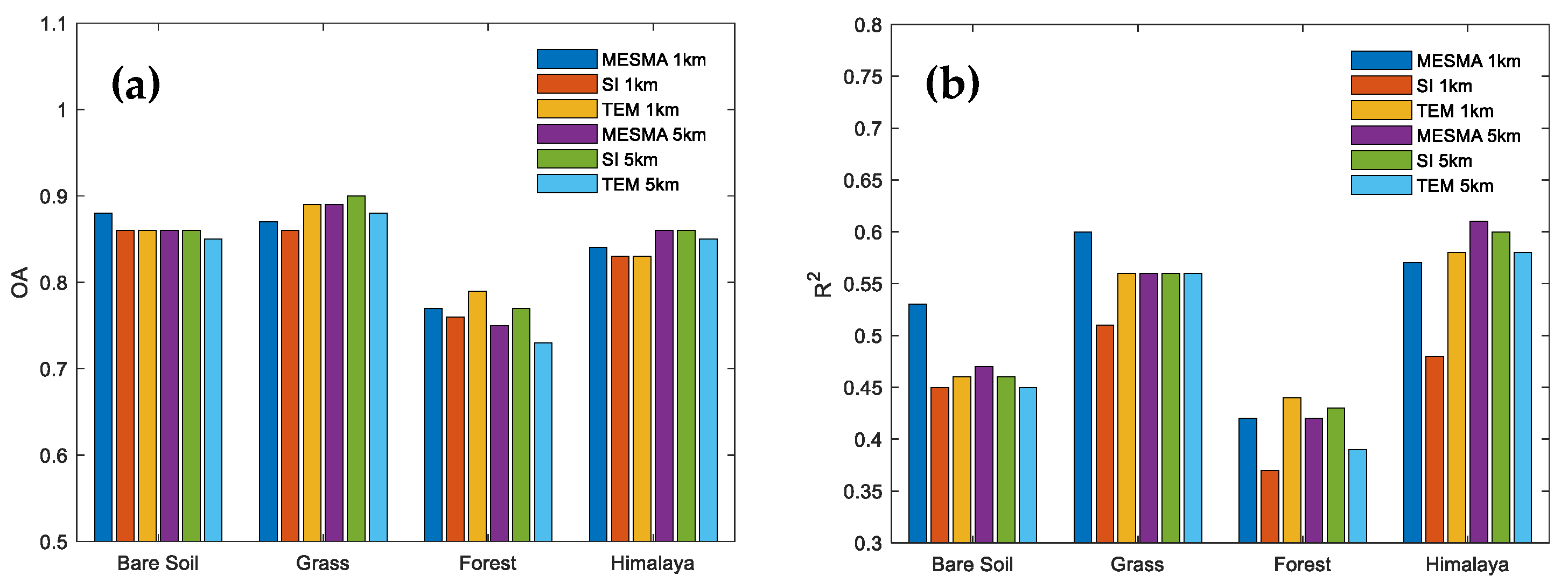

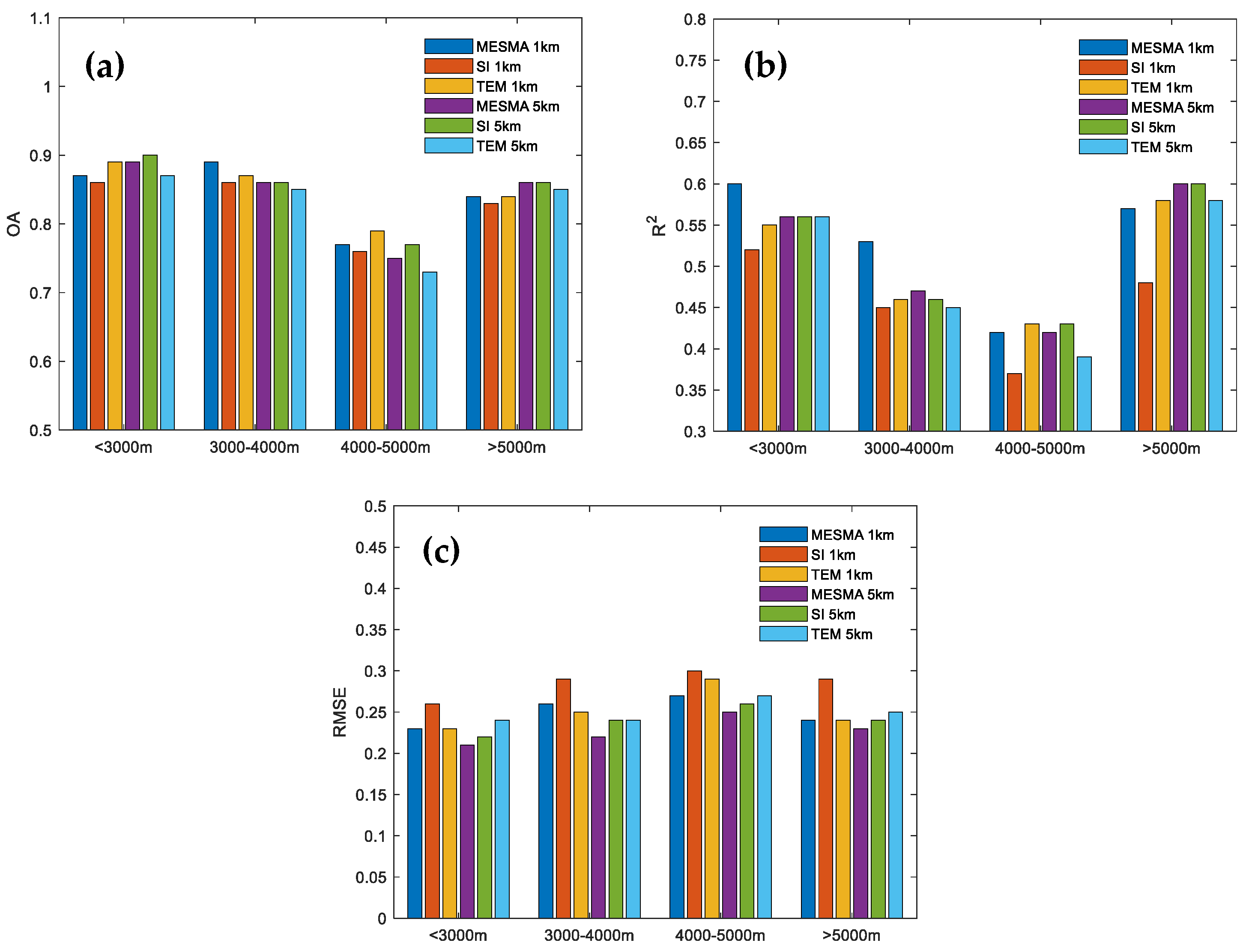
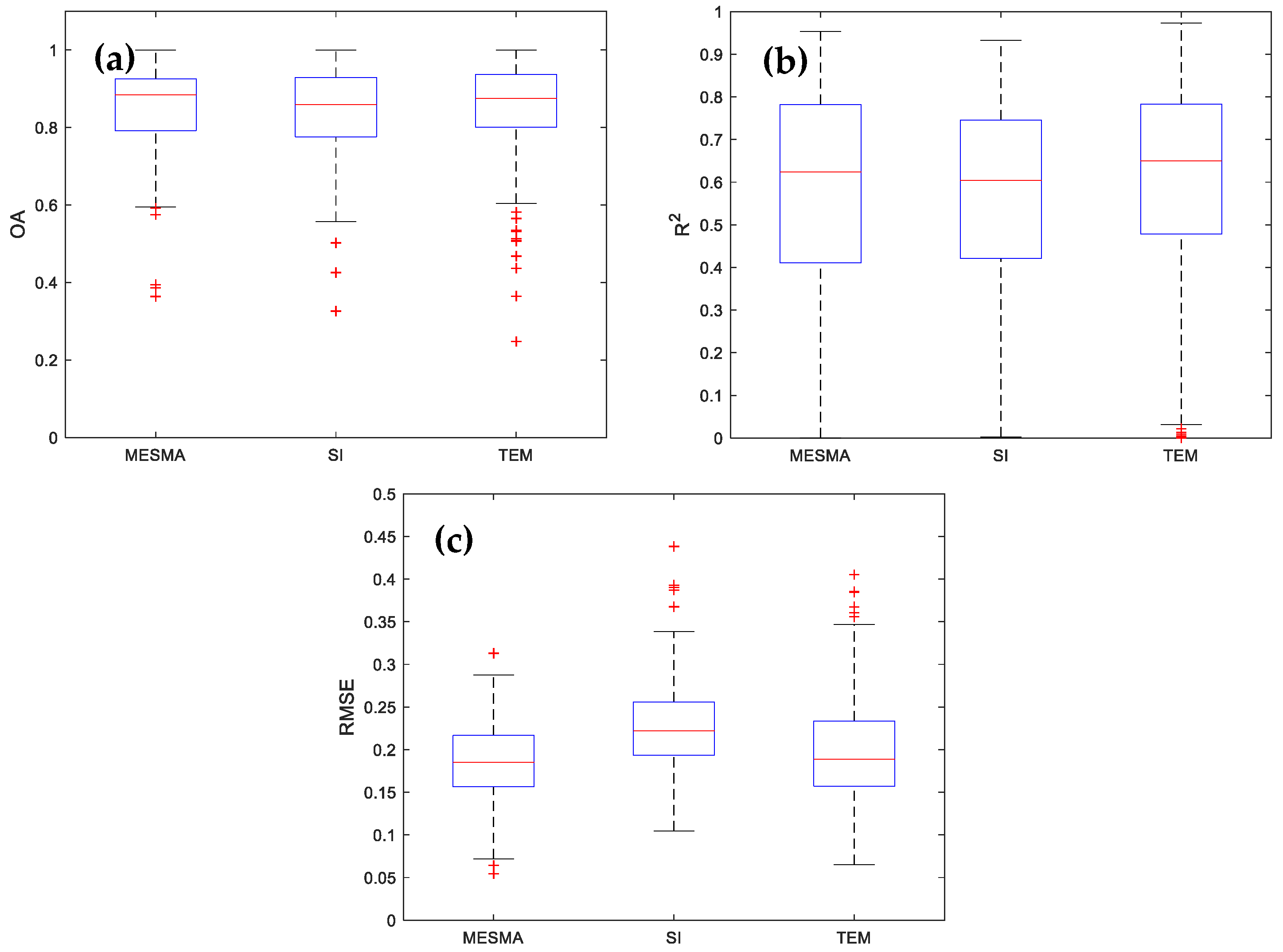
| Band Number | Spectral Range (μm) | Central Wavelength (μm) | Spatial Resolution (km) |
|---|---|---|---|
| 1 | 0.55–0.68 | 0.615 | 1/5 |
| 2 | 0.725–1.1 | 0.912 | 1/5 |
| 3 | 3.55–3.93 | 3.75 | 1 |
| 4 | 10.3–11.3 | 10.80 | 1/5 |
| 5 | 11.5–12.5 | 12.00 | 1/5 |
| Band Number | Spectral Range (μm) | Central Wavelength (μm) | Spatial Resolution (km) |
|---|---|---|---|
| 1 | 0.45–0.52 | 0.48 | 30 m |
| 2 | 0.52–0.60 | 0.56 | 30 m |
| 3 | 0.63–0.69 | 0.66 | 30 m |
| 4 | 0.76–0.90 | 0.83 | 30 m |
| 5 | 1.55–1.75 | 1.65 | 30 m |
| 6 | 10.4–12.5 | 11.45 | 120 m |
| 7 | 2.08–2.35 | 2.20 | 30 m |
| Endmember | Rule for 1 km Data | Rule For 5 km Data |
|---|---|---|
| Full snow cover | SI > 0.70 | SI > 0.75 |
| RVIS > 0.2 for forest | RVIS > 0.5 for forest | |
| RVIS > 0.25 for other land cover | RVIS > 0.6 for other land cover | |
| Snow-free | SI < 0.50, | SI < 0.50, |
| RVIS < 0.2 for grass and crop | RVIS < 0.5 for grass and crop | |
| RVIS < 0.25 for barren and forest | RVIS < 0.6 for barren and forest |
| Endmember | Rule For 1 Km Data | Rule For 5 Km Data |
|---|---|---|
| Snow | NDSI > 0.8 & NDVI < 0.05 & RVIS > 0.35 | NDSI > 0.8 & NDVI < 0.2 & RVIS > 0.65 |
| Vegetation | NDSI < 0.5 & NDVI > 0.1 | NDSI < 0.2 & NDVI > 0.15 |
| Bare land | NDSI < 0.3 & −0.15 < NDVI < 0 | NDSI < 0.3 & −0.15 < NDVI < 0.1 |
Publisher’s Note: MDPI stays neutral with regard to jurisdictional claims in published maps and institutional affiliations. |
© 2022 by the authors. Licensee MDPI, Basel, Switzerland. This article is an open access article distributed under the terms and conditions of the Creative Commons Attribution (CC BY) license (https://creativecommons.org/licenses/by/4.0/).
Share and Cite
Pan, F.; Jiang, L.; Zheng, Z.; Wang, G.; Cui, H.; Zhou, X.; Huang, J. Retrieval of Fractional Snow Cover over High Mountain Asia Using 1 km and 5 km AVHRR/2 with Simulated Mid-Infrared Reflective Band. Remote Sens. 2022, 14, 3303. https://doi.org/10.3390/rs14143303
Pan F, Jiang L, Zheng Z, Wang G, Cui H, Zhou X, Huang J. Retrieval of Fractional Snow Cover over High Mountain Asia Using 1 km and 5 km AVHRR/2 with Simulated Mid-Infrared Reflective Band. Remote Sensing. 2022; 14(14):3303. https://doi.org/10.3390/rs14143303
Chicago/Turabian StylePan, Fangbo, Lingmei Jiang, Zhaojun Zheng, Gongxue Wang, Huizhen Cui, Xiaonan Zhou, and Jinyu Huang. 2022. "Retrieval of Fractional Snow Cover over High Mountain Asia Using 1 km and 5 km AVHRR/2 with Simulated Mid-Infrared Reflective Band" Remote Sensing 14, no. 14: 3303. https://doi.org/10.3390/rs14143303
APA StylePan, F., Jiang, L., Zheng, Z., Wang, G., Cui, H., Zhou, X., & Huang, J. (2022). Retrieval of Fractional Snow Cover over High Mountain Asia Using 1 km and 5 km AVHRR/2 with Simulated Mid-Infrared Reflective Band. Remote Sensing, 14(14), 3303. https://doi.org/10.3390/rs14143303






